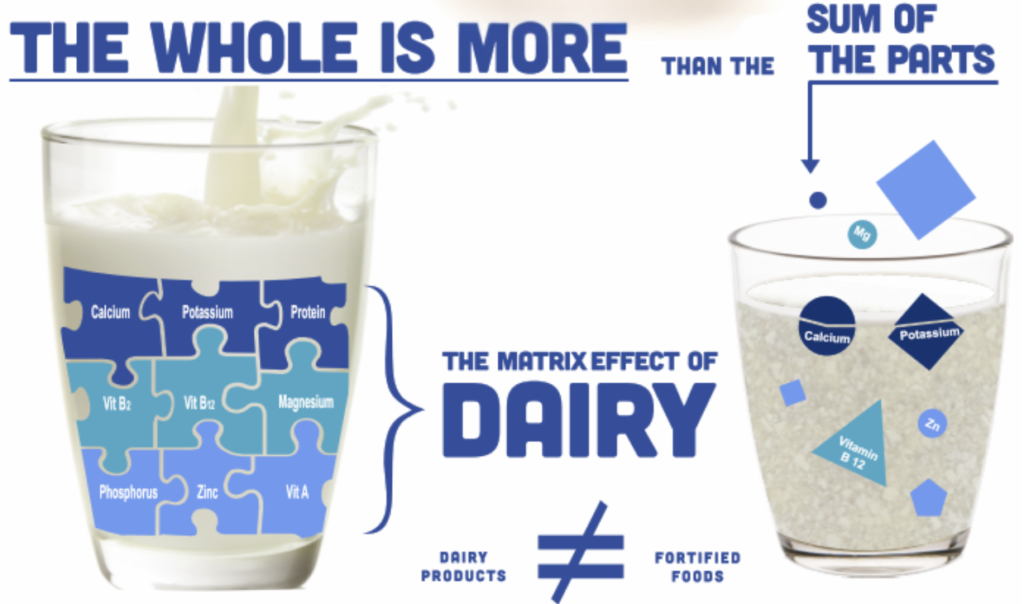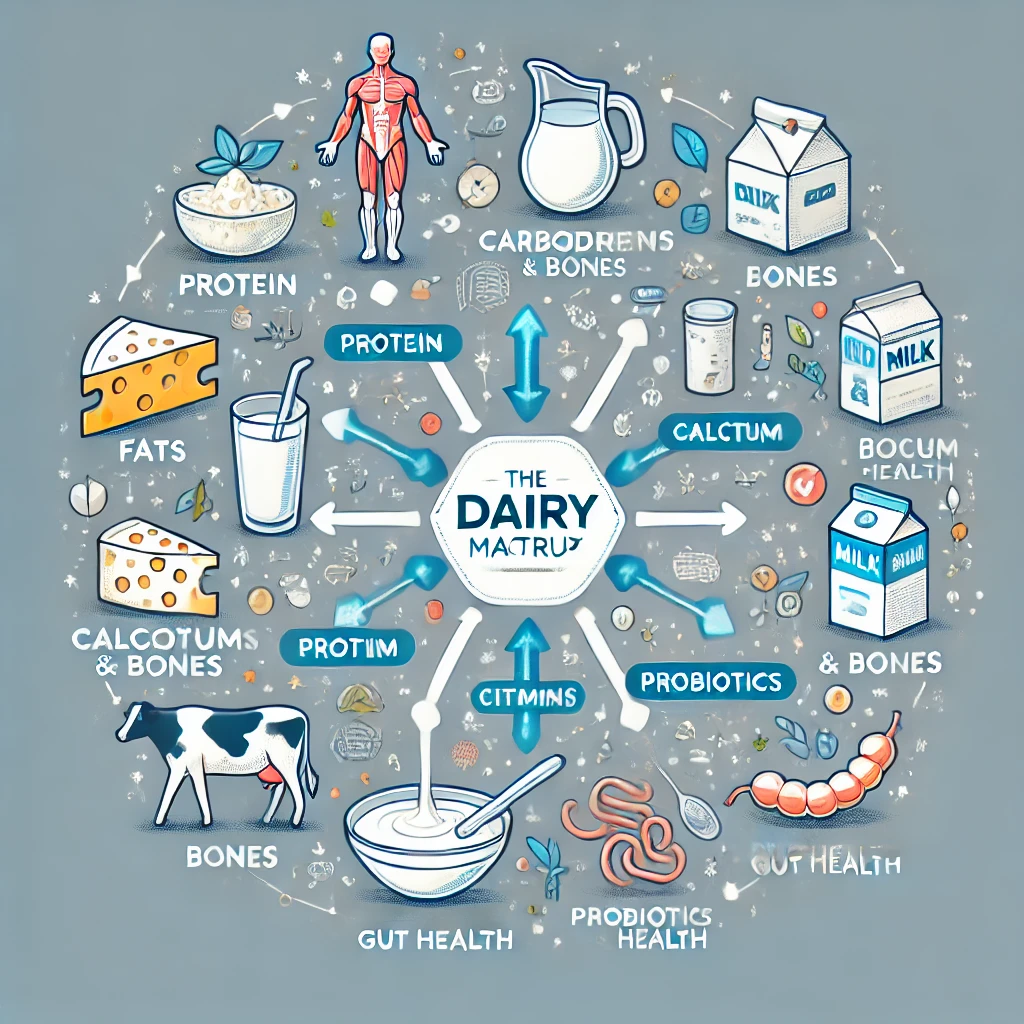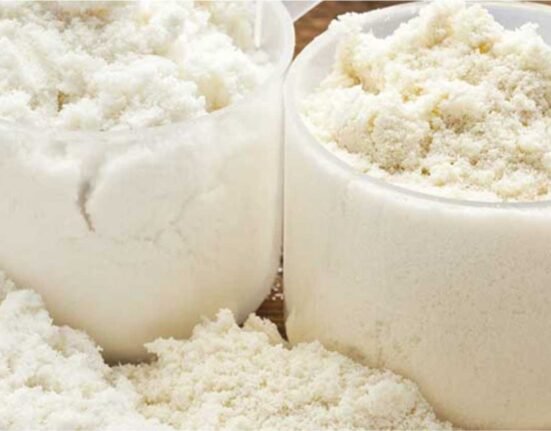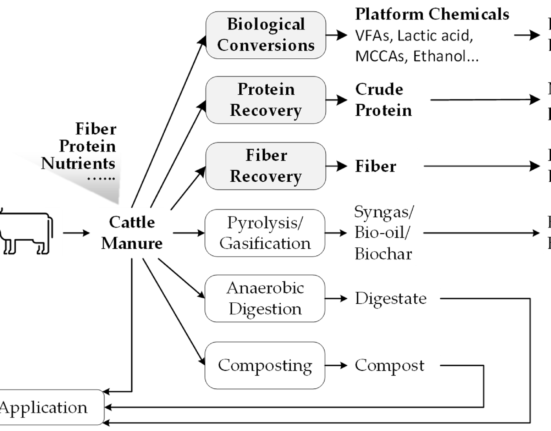In today’s fast-paced world, nutrition science often takes a reductionist approach, breaking down food into its components—calories, protein, fat, and vitamins. While this method helps us understand nutrient composition, it oversimplifies how food interacts with our bodies.
The concept of the Dairy Matrix challenges this limited perspective. It highlights that food is a collection of isolated nutrients and a complex, structured system where nutrients interact to enhance health benefits. This shift in understanding has significant implications for healthcare, dietary guidelines, and food production.
What is the Dairy Matrix?
 The Dairy Matrix refers to the unique interaction between nutrients, bioactive compounds, and the physical structure of dairy products. Unlike synthetic supplements or artificially fortified foods, natural dairy products contain a complex, three-dimensional structure where components work synergistically to influence digestion, nutrient absorption, metabolism, and overall health.
The Dairy Matrix refers to the unique interaction between nutrients, bioactive compounds, and the physical structure of dairy products. Unlike synthetic supplements or artificially fortified foods, natural dairy products contain a complex, three-dimensional structure where components work synergistically to influence digestion, nutrient absorption, metabolism, and overall health.
For instance, in whole milk, calcium, phosphorus, and vitamin D do not function separately but work together to improve bone health. Similarly, in cheese and yoghurt, the fermentation process enhances probiotic activity, positively impacting gut health and immunity.
This means that dairy products like milk, yoghurt, cheese, and butter do not merely supply nutrients—they create physiological effects that cannot be replicated by consuming isolated nutrients in supplement form.
Beyond Nutrients: The Health Effects of Dairy
Scientific research increasingly supports the holistic benefits of dairy products, emphasizing that their biological impact goes beyond individual nutrient content. Here’s how the Dairy Matrix plays a vital role in human health:
1. Cardiovascular Health: Beyond the Saturated Fat Myth
Traditionally, full-fat dairy has been criticized for its saturated fat content. However, recent studies show that not all saturated fats are harmful. The Dairy Matrix modifies how fats interact with the body, reducing potential adverse effects.
- Cheese consumption has been linked to neutral or beneficial effects on heart health.
- Yoghurt intake has been associated with a lower risk of hypertension and metabolic disorders.
- Whole dairy products contain bioactive compounds such as milk fat globule membranes (MFGM), which may help reduce inflammation and support cardiovascular health.
2. Bone Health: More Than Just Calcium
Many people associate calcium with strong bones, but calcium alone is not enough. Bone health relies on the synergy between calcium, vitamin D, phosphorus, and high-quality proteins—all naturally present in dairy.
- Milk and yoghurt provide the ideal combination of these nutrients, promoting bone density and reducing the risk of osteoporosis.
- Dairy proteins, including casein and whey, support muscle growth and bone regeneration, making dairy particularly important for athletes and ageing populations.
3. Gut Microbiome & Digestion: The Role of Fermented Dairy
Fermented dairy products like yoghurt, kefir, and aged cheeseare crucial ton gut health. They contain probiotics (beneficial bacteria) that:
- Enhance digestion and reduce symptoms of lactose intolerance.
- Improve gut microbiome balance, linked to better immunity and reduced inflammation.
- Support nutrient absorption, ensuring the body utilizes minerals like iron and zinc more effectively.
4. Weight Management: The Satiety Factor
Unlike refined carbohydrates or processed foods, dairy proteins and healthy fats contribute to long-lasting satiety, which helps regulate appetite and prevent overeating.
- Whey protein in milk and yoghurt stimulates the production of hormones like GLP-1, which promote a feeling of fullness.
- Studies show that individuals who consume dairy as part of a balanced diet tend to maintain healthier body weights than those who avoid dairy.
Why This Matters for the Food Industry
The Dairy Matrix concept transforms food processing, formulation, and marketing approaches. Here’s why it is crucial for dairy product manufacturers, nutritionists, and policymakers:
1. Moving Beyond Nutrient Fortification
Many processed foods today are fortified with isolated vitamins and minerals, but research shows that simply adding synthetic nutrients does not recreate the full benefits of natural dairy products.
- Example: Fortifying plant-based milk alternatives with calcium does not ensure the same absorption level as in natural milk, where calcium is combined with other bioavailable compounds.
- Lesson for the industry: Instead of breaking down food into individual components, manufacturers should focus on preserving the natural structure of dairy in their products.
2. Expanding the Market for Functional Dairy Products
As consumer demand for functional foods increases, companies must explore leveraging the Dairy Matrix to create innovative, health-enhancing products.
- Dairy proteins (whey and casein) are already used in sports nutrition and medical foods.
- Probiotic-rich dairy is gaining traction as a gut-health-friendly option for digestive wellness.
- Whole-fat dairy options are returning as research debunks the myth that fat-free products are healthier.
3. Optimizing Dairy Processing Methods
Understanding the Dairy Matrix also impacts processing techniques. Some ultra-processed dairy products strip away valuable components, reducing their potential health benefits.
- Example: Traditional cheese-making preserves essential bioactive compounds, while highly processed cheese spreads may lack these benefits.
- Future direction: The industry must invest in processing technologies that retain the natural dairy structure while ensuring shelf stability and safety.
Conclusion: The Dairy Matrix is the Future of Nutrition
The Dairy Matrix is reshaping our understanding of food and nutrition. It underscores the importance of whole foods over isolated nutrients, offering compelling evidence that dairy products provide unique health benefits beyond their basic nutrient profiles.
As more research emerges, the focus should shift from nutrient isolation to preserving food’s natural structure, ensuring better health outcomes, improved food quality, and sustainable dietary recommendations.
For consumers, this means embracing whole, minimally processed dairy foods for optimal health. For the food industry, it calls for a revolution in dairy processing and product innovation. And for policymakers, it presents an opportunity to redefine dietary guidelines based on cutting-edge nutritional science.
The Dairy Matrix is not just a concept—it’s the key to unlocking the full potential of food as nature intended.







